This blog posting covers recent trips I made down to East Ayrshire to conduct Upland Breeding Bird Surveys on behalf of the BTO (British Trust for Ornithology). The survey site is a 1km square of upland heath and bog lying on the northeast shores of Loch Doon, which is at least half an hour walk from the nearest layby on the A713.
I normally travel down to Loch Doon the afternoon before the survey at stay at the Loch Doon Caravan Park (on the opposite side of the loch) so I can get up early and start my survey before 8:30am. I carry out two surveys each year; one around the beginning of May (Early Survey) and the other in early June (Late Survey). I probably take more photos and videos before and after the surveys as I am usually too busy during the surveys.
Let's start with this year's Early Survey when I went down to Loch Doon on the last day of April. Once I had park up at the Caravan Park I went for a walk along the side of the loch:
It was a lovely afternoon and I was enjoying my stroll along the shores of the loch taking photographs of any birds I saw:
As well as birds on the water there were birds everywhere, even on the overhead cables near to the Caravan Park:
The Meadow Pipit is a relatively common upland species, as is the following bird:
I headed back to the motorhome to make myself something for my tea.
Afterwards it was such a lovely evening I decided to have another stroll around the area:
 |
| Loch Doon, early evening |
I watched a couple of Oystercatchers wandering about in a nearby field:
 |
| Oystercatcher in nearby field |
 |
| A pair of Oystercatchers |
In case you were wondering what they were up to, this video might shed some light on the matter:
Yes it's that time of year when birds you are more use to seeing on the coast head inland (and often upland) to breed. This can include gulls, waterfowl and waders such as these Oystercatchers, seeking safer habitats with fresh water nearby to raise their young.
The sun was starting to get lower in the sky so I headed back towards the caravan park, passing by the nearby Craiglea Burn:
 |
| Twilight at Loch Doon |
 |
| Sunset over the Craiglea Burn |
 |
| Craiglea Burn near Caravan Park |
 |
| Last View of the Evening |
Next morning was survey morning and I got up early (5:30am to be precise) in order to get myself washed, dressed and fed, ready to move the van round to the survey site.
It was a lovely morning when I got up and it remained nice (if a bit misty) when I reached the layby near to the survey site:
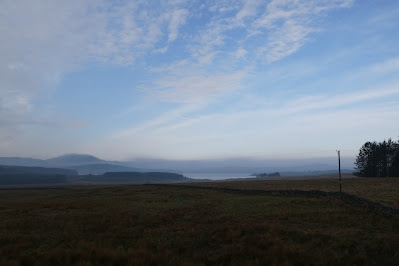 |
| Early Morning at Loch Doon Caravan Park |
 |
| Lovely Morning at the Survey Site |
Although some low cloud and mist had formed over the hills and loch, visibility remained good at the survey site.
At the start of the survey I had some good views of a male Wheatear; initially it was on a post next to the dam, before moving to the rough grass nearby:
 |
| Male Wheatear on Fence Post near Dam Wall |
 |
| Male Wheatear |
 |
| Male Wheatear on Rough Grassland |
 |
| Male Wheatear, Loch Doon |
Such a stunning bird.
As well as looking and listening for birds during the survey I also like to take note of any other wildlife I see, whether it be mammals, insects or wildflowers:
 |
| Drinker Moth Caterpillar next to Wood Anenome |
 |
| Drinker Moth Caterpillar |
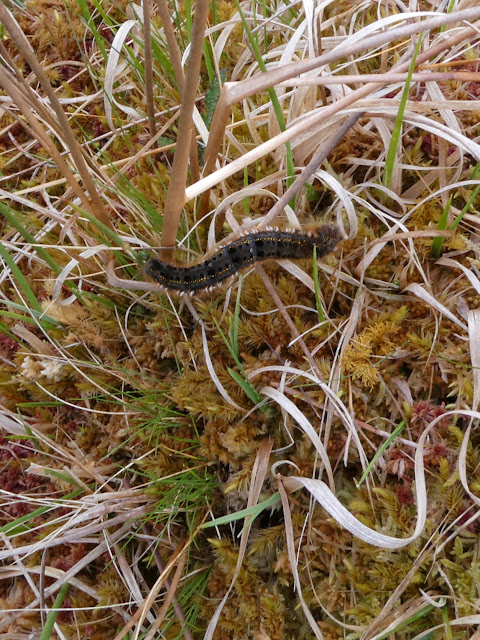 |
| Drinker Moth Caterpillar on the move |
 |
| Pretty Wood Anemone |
There is a small patch of mixed woodland within my survey area, but despite it's small size and relative remoteness it can still throw up some interesting birds, such as this little Willow Warbler:
I don't take many photos/videos during my survey as I try to concentrate on what I am doing, but if an opportunity arises , like the Willow Watcher, I will try to capture it on film.
I carried on with my survey until I reached the halfway mark, which happens to be at the top of the hill; here I had a break and took some photos of the misty views:
 |
| Mist over the Southern Uplands |
 |
| Mist over Loch Doon |
 |
| Misty View |
I had a quick snack then carried on with the second half of my survey.
Halfway through the second half of the survey I stopped to take some photos of a Skylark which was obligingly perched on top of a rock:
 |
| Skylark during Survey |
 |
| Skylark perched on a rock |
The second half of the survey is all downhill (literally) and ends up on the shores of the Loch Doon. Even though it is downhill it is still a tough slog yomping through the heather and the boggy ground, always pleased to see the water's edge which marks the end of the survey:
 |
| View of Loch Doon shoreline |
 |
| Reaching the water's edge and the end of the survey |
This last portion of the survey can often be the place where I see the most diverse range of birds. The open moorland is normally dominated by three main species (Meadow Pipit, Skylark and Wheatear) although sometimes I get others such as Raven, Red Kite, Curlew, Cuckoo etc. When I reach the water's edge I can get various ducks and geese, waders, martins and swallows, gulls, etc. due to the different habitats that exist.
 |
| Common Sandpiper at water's edge |
 |
| Common Sandpiper, Loch Doon Survey |
Always nice to see a Common Sandpiper during my survey.
One other species I saw was less welcome as they were making an awful din when I first saw (heard) them.
 |
| Canada Geese on Loch Doon |
 |
| Canada Goose |
They did quieten down after their initial arrival.
So that was basically the end of my Upland Breeding Bird Survey for June; where I recorded a total of 17 different bird species (no I didn't photograph them all)
I now had the pleasure of a long slog along the side of the loch and over moorland until I reached the starting point for my survey. Thereafter I had to follow the rough track back to the roadside then along the road to the layby for a welcome rest (and some lunch) in the motorhome.
Luckily I still had some interesting birds to watch on my return journey, including this striking Whinchat:
 |
| Male Whinchat on Post |
 |
| Striking Male Whinchat |
That basically concludes my Early (May) survey story.
Some five weeks later I was back down at Loch Doon to carry out my Late (June) survey. Once again I headed down to Loch Doon Caravan Park the day before my survey, and even before I got the van fully set up there were birds to see around the campsite:
 |
| Common Gull at Caravan Park |
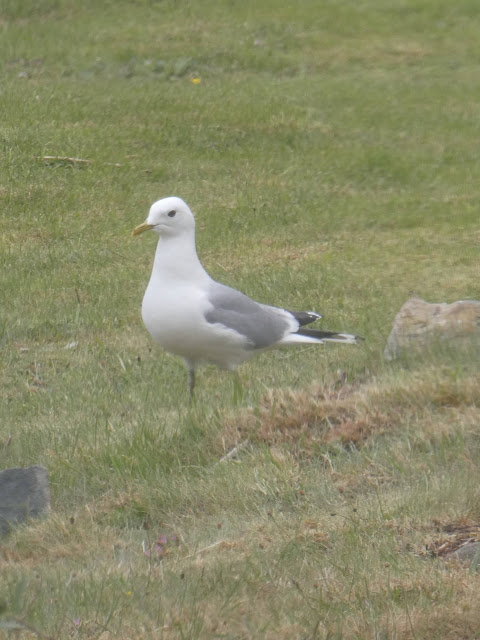 |
| Common Gull from Motorhome window |
 |
| Pied Wagtail at Caravan Park |
Unlike the first visit there had been a lot of rain in the days leading up to my arrival, so I was interested to see how that had impacted on the local wildlife. Certainly the flow of water coming down the Craiglea Burn had increased:
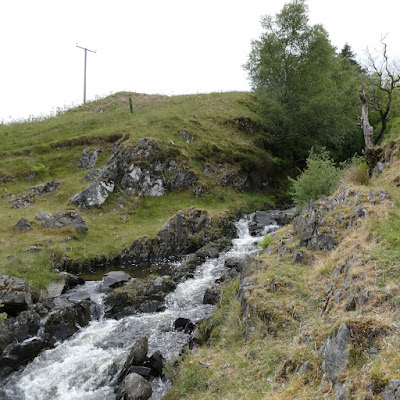 |
| Craiglea Burn near to Caravan Park |
 |
| Craiglea Burn as it enters Loch Doon |
The flow down the burn is probably better represented in this video:
Although it wasn't raining when I had a walk along the shoreline, it was pretty overcast and showers were not that far away. This however did not detract from the beautiful views of the lochside:
 |
| Industrial Ruins alongside the Loch |
 |
| Loch Doon from the shore |
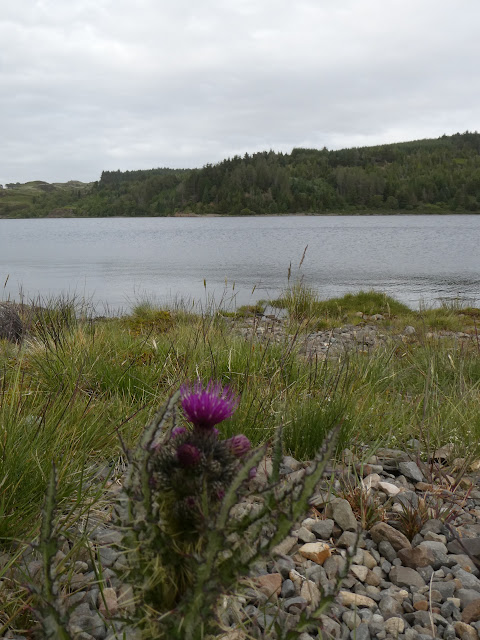 |
| Thistle at Loch Doon |
 |
| Rocky Shoreline |
 |
| Foxglove at Loch Doon |
The wet weather hadn't been detrimental to the local wildflowers, and it looked like the local bird life hadn't suffered much either:
 |
| Male Wheatear on grass near loch |
 |
| Male Wheatear |
 |
| Male Wheatear on post |
Along the shoreline some potential breeding birds were on show, this Common Sandpiper was performing a breeding display and song:
 |
| Common Sandpiper on the rocks |
 |
| Common Sandpiper |
Although I got the bird on video it wasn't doing it's song and dance routine at the time:
It started to rain again so I headed back to the motorhome for some shelter and something to eat.
After teatime the rain let up a bit so I went for a stroll near to the caravan park. There weren't too many birds about but there were plenty of midges and flies; which did attract some insectivores, like this juvenile Pied Wagtail:
 |
| Juvenile Pied Wagtail on post |
And there were lots of Sand Martins flying around picking off the abundance of midges and flies. Almost impossible to take a good photo of a flying Sand Martin, but I did manage to capture a few on video (blink and you will miss them):
Best I could do.
Next morning I was up bright and early again, hoping the rain would stay off until I completed my survey, nothing worse than getting soaked when you are up on a moorland without any shelter nearby. Luckily the weather was overcast but dry when I got up, had my breakfast, sorted my stuff out and headed to the survey site.
I pulled into the layby near the survey site and I was just about to head out when the heavens opened and the rain poured down. It was almost half an hour later until the rain eased off, allowing me to start my hike towards the survey site. Just before I arrived at the survey start point I was pleased to see a pair of Whinchat flitting about amongst the gorse and scrubby grass:
 |
| Female Whinchat |
 |
| Male Whinchat on Gorse Bush |
 |
| Male Whinchat |
Nice bird to see, less common round here than the Stonechat, hope it's a breeding pair.
Just like my first survey there were plenty of Drinker Moth caterpillars about, I'm sure some birds must eat them. Come to think about it I saw a Cuckoo during a previous survey eating what looked like a juicy caterpillar.
 |
| Drinker Moth Caterpillar |
 |
| Potential Cuckoo Snack? |
I headed on towards the Dam and the start of my survey:
 |
| Heading towards the Dam Wall |
As I approached I could see a bird on top of the Dam Wall, a quick check with my binoculars revealed it was a Stonechat:
 |
| Stonechat on Dam Wall |
 |
| Male Stonechat at Loch Doon |
Looks like a good day for a Chat:
I carried on with my survey until I reached the small wooded area halfway up the hill. As I stopped for a few minutes to see what was around I noticed an unfamiliar bird in the trees, it was silhouetted against the sky so hard to identify, but it's shape and behaviour made me think of one bird only:
 |
| Spotted Flycatcher |
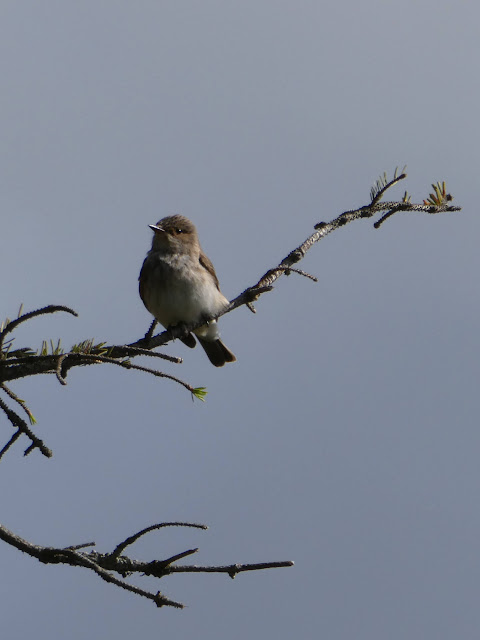 |
| Spotted Flycatcher in Tree |
 |
| Spotted Flycatcher Loch Doon |
 |
| Flycatcher flies off to catch some flies |
I hung about long enough for me to get a video as well:
I stopped at my usual place half way through the survey, thankful that the rain had stayed off, so I took the obligatory photos:
 |
| Loch Doon and the Southern Uplands |
 |
| Loch Doon from the top of the hill |
 |
| Loch Doon, halfway through survey |
I carried on with the second half of my survey, within 15 minutes the rain started. It wasn't too heavy but very annoying, I kept my camera in my pocket as I did not want it to get wet. There was very little to see anyway, the birds did not want to come out and fly in the rain. In fact even the shoreline and loch at the end of the survey was quiet, and this is usually one of the busiest spots.
After the survey finished I turned East and headed back towards the dam, at least now the rain was on my back and not in my face.
During this survey I identified 11 different species, quite a bit less than the 17 species identified the previous month, which I put down to the very wet weather we had in the days leading up to the second survey. Never mind, the Spotted Flycatcher was a first for this survey area, so some good news.
As the rain eased on the way back to the motorhome I stopped a few times to take some photos and videos, including this Skylark performing its display flight:
Very difficult to film, even though you can hear them loud and clear when they are display calling, they are often very high and just a speck in the sky. I slowed the video down a bit so you could better see the action of the bird.
There were Skylarks everywhere, one even landed on a nearby dry stane dyke, which I just had to capture on film:
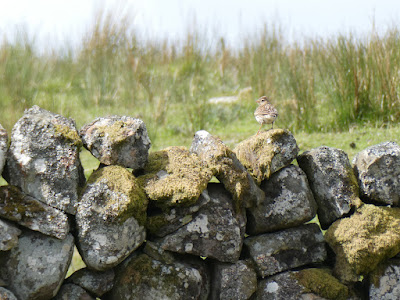 |
| Skylark on Dry Stane Dyke |
 |
| Skylark Calling |
Sorry went a bit fuzzy near the end.
My last bird for this blog is a Wheatear I saw on the way back to the van, not the stunning male which has already featured in this blog, instead the more subtle but no less beautiful Female Wheatear:
 |
| Female Wheatear on the grass |
 |
| Female Wheatear |
That concludes this blog posting, hope you enjoyed coming along with me on my Upland Breeding Bird Surveys.
I bet you are glad you didn't have to do all the walking through the bogs and moorland in all sorts of weather.
Take Care
Teddy Edward











































































No comments:
Post a Comment